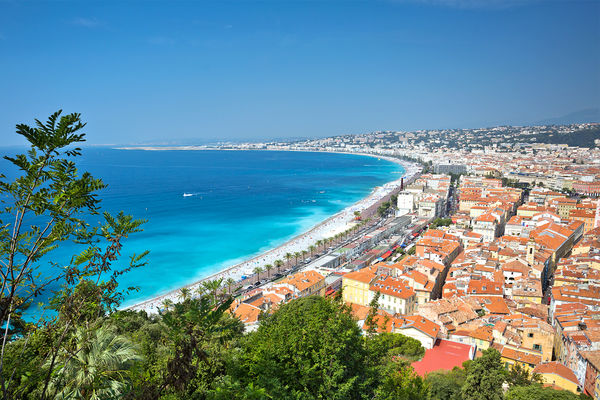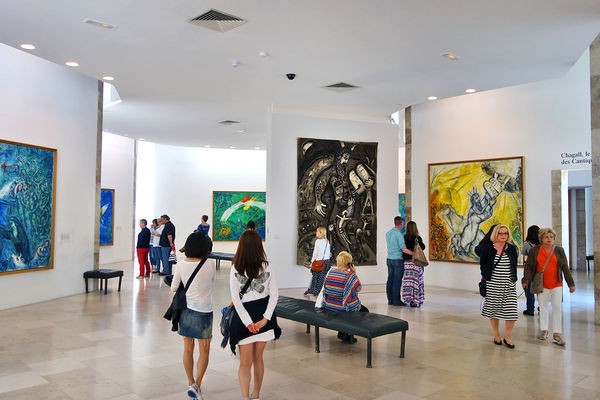Basking in the French Riviera’s Lively, Luminous Art
By Rick Steves

With its romantic coastline, inviting beaches, and reliable sunshine, southern France's Riviera region has been a tourist destination since the 1860s. In the 1920s, aristocrats from London to Moscow flocked here to socialize, gamble, and escape the dreary weather at home. But the area also attracted a Who's Who of 20th-century artists, who were drawn by the Mediterranean's bohemian atmosphere, luminous light, and contrasting colors of sea, sand, and sky.
The legacies of the many artists who worked in the south — including Pierre-Auguste Renoir, Henri Matisse, Marc Chagall, Georges Braque, Raoul Dufy, Fernand Léger, and Pablo Picasso — are memorialized today in an intriguing collection of museums. And visiting them is easy, as none of them tend to be plagued by the long lines and crowds of major museums in Europe's big cities (leaving you plenty of time for the beach). Here are some of my favorites:
Renoir Museum, Cagnes-sur-Mer
In 1907 Pierre-Auguste Renoir, whose Impressionist paintings straddled the last turn of the century, built a house and workshop for himself in Cagnes-sur-Mer (halfway between Nice and Antibes). By then an old man, Renoir would spend his last 12 years in this little village happily tending his fruit trees, painting in his studio, and dabbling in sculpture. You can see his atelier, with his easel and palette still in place (as well as his wheelchair and canes), and some original paintings.
Matisse Museum, Nice
Henri Matisse, the master colorist, first came to Nice in 1917, leaving behind financial struggles and a difficult marriage in Paris. He would remain in the Riviera, on and off, until his death in 1954. Though this museum's collection is slender, you can see typical examples of a range of his favorite motifs (flowers, fruit, female nudes) as well as his love of decorative patterns and joyful color.
Chagall Museum, Nice
Marc Chagall settled in the Riviera after World War II. His best-known paintings feature a magical-realist style that conjures up his native Russia, with fiddlers on roofs and horses in flight. Chagall had a hand in designing this delightful museum, which includes his Biblical Message cycle: 17 large luminous canvases on biblical themes, painted in bright reds, blues, and greens that manage to combine aspects of his Russian-Jewish heritage with the Christian story.
Picasso Museum, Antibes
Pablo Picasso, the pioneer of Cubism, summered on the Riviera nearly every year from 1919 until he died in 1973. He had hunkered down in Paris for most of World War II, but in 1946 he returned to Antibes, on the coast, where he spent a productive part of a year working in the town's landmark Château Grimaldi. Forced to improvise his materials after the shortages of the war years, but elated by the newfound peace (and a new girlfriend), Picasso produced an amazing volume of celebratory, colorful artworks. The compact museum now housed in the Grimaldi offers a manageable look at the paintings and sketches Picasso made there.
Picasso Museum, Vallauris
After his sabbatical in Antibes, Picasso moved on to Vallauris, a typical Riviera village midway between Antibes and Cannes. The little town was home to several active art potteries, and Picasso became so enamored by the ceramics he saw that he resolved to take up clay as a medium. He ended up staying in Vallauris until 1955, and the museum there is a good place to become acquainted with his playful approach to ceramic art.
Maeght Foundation, St-Paul-de-Vence
This inviting, private museum, situated just above the inland town of St-Paul-de-Vence, offers an excellent introduction to modern Mediterranean art. Its founder, the Parisian art dealer Aimé Maeght, purchased an arid hilltop in the 1960s, planted it with 35,000 trees and shrubs, and hired the Catalan architect José Luis Sert to design a museum for his collection. Today it gathers under one roof the work of many famous modern artists (Fernand Léger, Joan Miró, Alexander Calder, Georges Braque, Marc Chagall). The lovely setting, with a verdant sculpture garden, is a bonus.
Chapel of the Rosary, Vence
Matisse convalesced from cancer surgery in 1941 with the help of a Dominican nun, and years later, in 1949, he repaid the favor by designing this tiny chapel in the hills above Nice. Deceptively simple, the chapel is tiled in plain white, with a few black-on-white line drawings (one depicts St. Dominic). But yellow, green, and blue stained-glass windows filter the sunlight, creating a cheery dance across the walls — expressing Matisse's irrepressible love of life. It's a space of light and calm that only a master could have created.
Thanks to these diverse museums, the Riviera has a cultural richness that's not typical of resort areas. The collections reflect the congenial joie de vivre of southern France: the playfulness, freedom, color, and beauty that inspires artists to this day.

